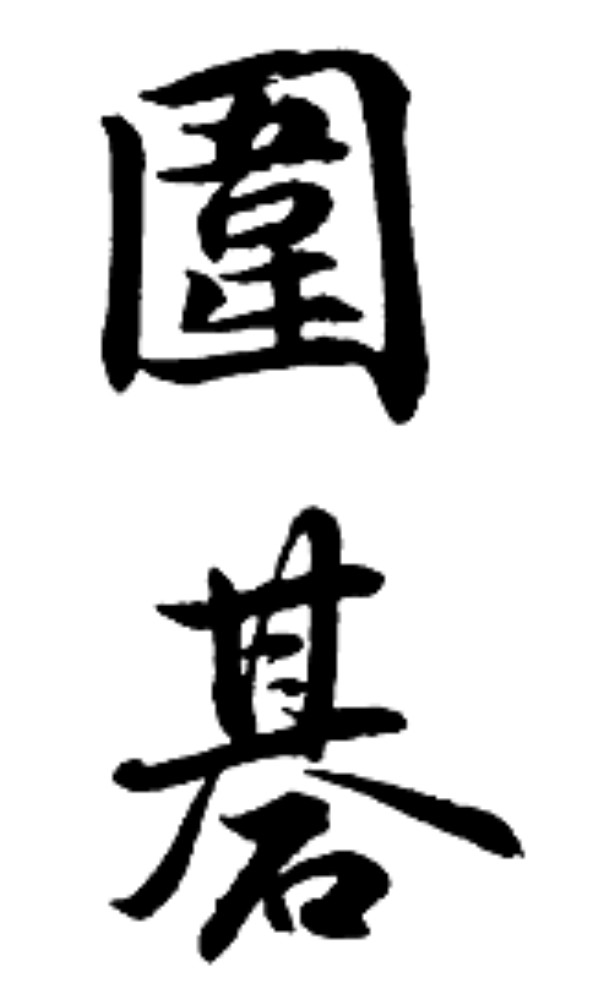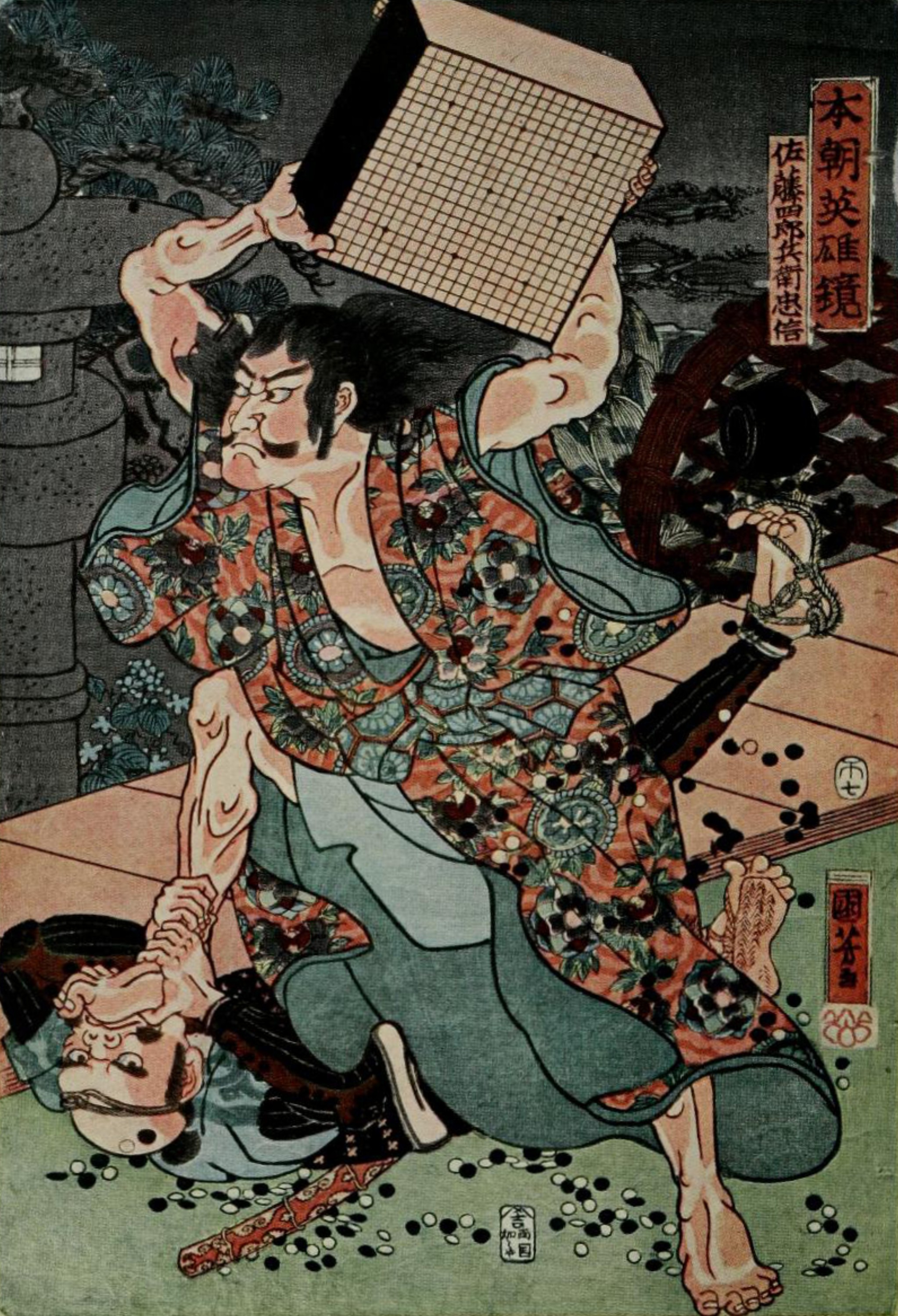 |
|
||
| Kellscraft
Studio Home Page |
Wallpaper
Images for your Computer |
Nekrassoff Informational Pages |
Web
Text-ures© Free Books on-line |
|
NATIONAL GAME OF JAPAN BY ARTHUR SMITH  MOFFAT, YARD & COMPANY 1908  SATO TADANOBU, A SAMURAI OF THE TWELFTH CENTURY, DEFENDING HIMSELF WITH A "GOBAN" WHEN ATTACKED BY HIS ENEMIES. From a print by Kuniyoshi THIS book is intended as a practical guide
to the game of Go. It is
especially designed to assist students of the game who have acquired a
smattering of it in some way and who wish to investigate it further at
their leisure. As far as I know there is no work . in the
English language on the game
of Go as played in Japan. There is an article on the Chinese game by Z.
Volpicelli, in Vol. XXVI of the "Journal of the China Branch of the
Royal
Asiatic Society." This article I have not consulted. There is also a
short
description of the Japanese game in a work on "Korean Games with Notes
on
the Corresponding Games of China and Japan," by Stewart Culin, but this
description would be of little practical use in learning to play the
game. There is, however, an exhaustive treatise
on the game in German by O.
Korschelt. This can be found in Parts 21-24 of the
"Mittheilungen der deutschen Gesellschaft für Natur and Völkerkunde
Ostasiens." The student could readily learn the game from Herr
Korschelt's
article if it were available, but his work has not been translated, and
it is
obtainable only in a few libraries in this country. In the preparation
of this
book I have borrowed freely from Herr Korschelt's work, especially in
the
chapter devoted to the history of the game, and I have also adopted
many of his
illustrative games and problems. Herr Korschelt was an excellent player,
and acquired his knowledge of
the game from Murase Shuho, who was the best player in Japan at the
time his
article was written (about 1880). My acquaintance with the game has been
acquired from Mr. Mokichi
Nakamura, a Japanese resident of this country, who is an excellent
player, and
whose enthusiasm for the game led me to attempt this book. Mr. Nakamura
has
also supplied much of the material which I have used in it. Toward the
end I
have had the expert assistance of Mr. Jihei Hashiguchi, with whom
readers of
the New
York Sun are already
acquainted. Wherever possible I have given the
Japanese words and phrases which are
used in playing the game, and for those who are not familiar with the
system of
writing Japanese with Roman characters, I may say that the consonants
have the
sounds used in English, and the vowels the sounds that are used in
Italian, all
the final vowels being sounded. Thus, "dame" is pronounced as though
spelled "dahmay." NEW YORK, April, 1908. THE game of Go
belongs to the class of games of which our Chess, though very
dissimilar, is an
example. It is played on a board, and is a game of pure skill, into
which the
element of chance does not enter; moreover, it is an exceedingly
difficult game
to learn, and no one can expect to acquire the most superficial
knowledge of it
without many hours of hard work. It is said in Japan that a player with
ordinary aptitude for the game would have to play ten thousand games in
order
to attain professional rank of the lowest degree. When we think that it
would
take twenty-seven years to play ten thousand games at the rate of one
game per
day, we can get some idea of the Japanese estimate of its difficulty.
The
difficulty of the game and the remarkable amount of time and labor
which it is
necessary to expend in order to become even a moderately good player,
are the
reasons why Go has not spread to other countries since Japan has been
opened to
foreign intercourse. For the same reasons few foreigners who live there
have
become familiar with it.
On the other hand, its intense interest is
attested by the following
saying of the Japanese: "Go uchi wa oya no shini me ni mo awanu,"
which means that a man playing the game would not leave off even to be
present
at the deathbed of a parent. I have found that beginners in this
country to
whom I have shown the game always seem to find it interesting, although
so far
I have known no one who has progressed beyond the novice stage. The
more it is
played the more its beauties and opportunities for skill become
apparent, and
it may be unhesitatingly recommended to that part of the community,
however
small it may be, for whom games requiring skill and patience have an
attraction. It is natural to compare it with our
Chess, and it may safely be said
that Go has nothing to fear from the comparison. Indeed, it is not too
much to
say that it presents even greater opportunities for foresight and keen
analysis. The Japanese also play Chess, which they
call "Shogi," but it
is slightly different from our Chess, and their game has not been so
well
developed. Go, on the other hand, has been zealously
played and scientifically
developed for centuries, and as will appear more at length in the
chapter on
the History of the Game, it has, during part of this time, been
recognized and
fostered by the government. Until recently a systematic treatment of
the game,
such as we are accustomed to in our books on Chess, has been lacking in
Japan.
A copious literature had been produced, but it consisted mostly of
collections
of illustrative and annotated games, and the Go masters seem to have
had a
desire to make their marginal annotations as brief as possible, in
order to
compel the beginner to go to the master for instruction and to learn
the game
only by hard practice. Chess and Go are both in a sense military
games, but the military
tactics that are represented in Chess are of a past age, in which the
king
himself entered the conflict — his fall generally meaning the loss of
the
battle — and in which the victory or defeat was brought about by the
courage of
single noblemen rather than through the fighting of the common soldiers. Go, on the other hand, is not merely a
picture of a single battle like
Chess, but of a whole campaign of a modern kind, in which the
strategical
movements of the masses in the end decide the victory. Battles occur in
various
parts of the board, and sometimes several are going on at the same
time. Strong
positions are besieged and captured, and whole armies are cut off from
their
line of communications and are taken prisoners unless they can fortify
themselves
in impregnable positions, and a far-reaching strategy alone assures the
victory. It is difficult to say which of the two
games gives more pleasure. The
combinations in Go suffer in comparison with those of Chess by reason
of a
certain monotony, because there are no pieces having different
movements, and
because the stones are not moved again after once being placed on the
board.
Also to a beginner the play, especially in the beginning of the game,
seems
vague; there are so many points on which the stones may be played, and
the
amount of territory obtainable by one move or the other seems
hopelessly
indefinite. This objection is more apparent than real, and as one's
knowledge
of the game grows, it becomes apparent that the first stones must be
played
with great care, and that there are certain definite, advantageous
positions,
which limit the player in his choice of moves, just as the recognized
Chess
openings guide our play in that game. Stones so played in the opening
are
called "Joseki" by the Japanese. Nevertheless, I think that in the
early part of the game the play is somewhat indefinite for any player
of
ordinary skill. On the other hand, these considerations are balanced by
the
greater number of combinations and by the greater number of places on
the board
where conflicts take place. As a rule it may be said that two average
players
of about equal strength will find more pleasure in Go than in Chess,
for in
Chess it is almost certain that the first of two such players who loses
a piece
will lose the game, and further play is mostly an unsuccessful struggle
against
certain defeat. In Go, on the other hand, a severe loss does not by any
means
entail the loss of the game, for the player temporarily worsted can
betake
himself to another portion of the field where, for the most part
unaffected by
the reverse already suffered, he may gain a compensating advantage. A peculiar charm of Go lies in the fact
that through the so-called
"Ko" an apparently severe loss may often be made a means of securing
a decisive advantage in another portion of the board. A game is so much
the
more interesting the oftener the opportunities for victory or defeat
change,
and in Chess these chances do not change often, seldom more than twice.
In Go,
on the other hand, they change much more frequently, and sometimes just
at the
end of the game, perhaps in the last moments, an almost certain defeat
may by
some clever move be changed into a victory. There is another respect in which Go is
distinctly superior to Chess.
That is in the system of handicapping. When handicaps are given in
Chess, the
whole opening is more or less spoiled, and the scale of handicaps, from
the
Bishop's Pawn to Queen's Rook, is not very accurate; and in one
variation of
the Muzio gambit, so far from being a handicap, it is really an
advantage to
the first player to give up the Queen's Knight. In Go, on the other
hand, the
handicaps are in a progressive scale of great accuracy, they have been
given
from the earliest times, and the openings with handicaps have been
studied
quite as much as those without handicaps. In regard to the time required to play a
game of Go, it may be said that
ordinary players finish a game in an hour or two, but as in Chess, a
championship game may be continued through several sittings, and may
last eight
or ten hours. There is on record, however, an authentic account of a
game that
was played for the championship at Yeddo during the Shogunate, which
lasted
continuously nine days and one night. Before taking up a description of the board and stones and the rules of play, we will first outline a history of the game. PREFACE INTRODUCTION I: HISTORY OF THE GAME II: DESCRIPTION OF THE BOARD AND STONES III: RULES OF PLAY IV: GENERAL METHODS OF PLAY AND TERMINOLOGY OF THE GAME V: ILLUSTRATIVE GAMES VI: "JOSEKI" AND OPENINGS VII: THE END GAME VIII: PROBLEMS |